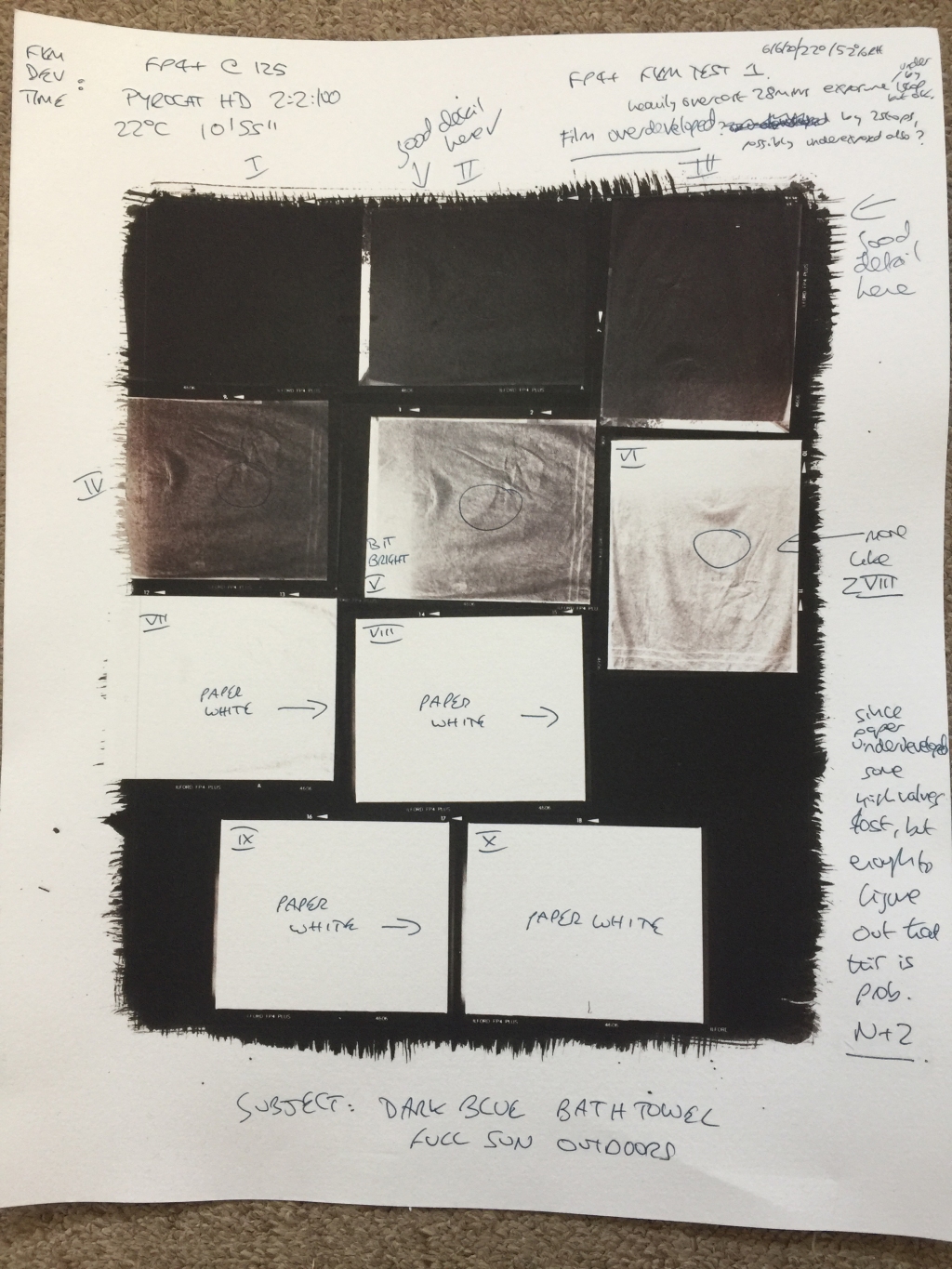FP4+ film speed and development testing for argyrotype printing
Following recent argyrotype printing sessions, and an increasing sense that my prints were both rather dark in the shadows, and more particularly losing a lot of detail in the highlights, I ran a print test following the guidelines for silver gelatin in John Blakemore’s Black and White Photography Workshop.
I exposed two rolls of FP4+ 120 in my RZ67 Pro II, using a dark blue bath towel set up in full sun in my back garden.
I exposed the film at box speed, 125, and shot a set of 10 zones, starting with zone 5 and then moving from zones 1-4 and 6-10.
I developed the first roll at my currently set development time (Pyrocat HD 2:2:100, 12’ at 21ºC, 10’55 at 22ºC, hand-developed in Jobo 1520 tank, which ought to approximate the results I get with 10×8 in the Stearman with the same time and agitation steps), and then printed it as a contact sheet with my usual Argyrotype set up. The resulting print is set out below, with hand-written notes, clearly demonstrating overdevelopment in loss of highlight detail.

On this basis, I then developed the second roll at N-2, and produced a much more satisfactory result.
I put quick phone-grabs of both negs in the final wash (before dry-down) through photoshop to produce a pair of zone scales from each print, as follows:

A second image of this strip for film 2 indicates the position of the zones on the histogram (with zones 1 and 2 both on zone 1 and zones 8 and 9 both on zone 9), demonstrating that, before dry-down, my zone 5 on the second sheet is a little dark, more like zone 4, and that zones 1-4 are probably one zone lower than where they should be, representing underexposure of the film by one stop:

And here is the same strip when the paper had dried.

This also indicates that I should rate my film at 64 for argyrotype prints with full tonal values starting from zones 2-3. I’m more bothered about loss of highlight detail than loss of shadow detail, so dev time is more significant I think. An extra stop of exposure on 10×8 will be quite substantial, but for images where full textural detail will be important I will want to be as creative as possible and go with 64 as film-speed if circumstances allow.
Here is the original contact sheet, now dried, from the second film with revised development time of 8’05” at 22ºC.

So new N dev = Pyrocat HD 2:2:100, 8’05”, 22ºC, ideally rating FP4+ at 64 where possible. Film hand-developed in Jobo 1520, to replicate as closely as possible the time and agitation I use for 10×8 in Stearman SP810 trays.
(NB I made an error in making the original exposures here: I shot two at zone VII, forgetting to change the lens aperture between shots at that point, so the two images on the penultimate row represent the same tonal position – their different colour represents slightly different sensitiser coating depth; I ran out of exposures on the roll, so the test finished at zone IX, which has very minor texture, from the shadows on the towel surface; zone X would be paper white).
Shooting a test with a textured subject, as John Blakemore recommends, makes a huge amount of sense.
The peach mid-tones here are very pleasant, and are controlled by the amount of humidity in the paper at time of exposure.
Altogether a stimulating and productive test. Will now to try it out on some new 10×8 subjects.





